Surface Finish Analysis in Single Point Incremental Sheet Forming of Rib-Stiffened 2024-T3 and 7075-T6 Alclad Aluminium Alloy Panels
Abstract
1. Introduction
2. Materials and Methods
2.1. Material
2.2. Forming Method
2.3. Analysis of Surface Roughness
2.4. Artificial Neural Networks
- Coefficient of determination, R2:
- Round mean square error, RMSE:where a is the actual value, p is the predicted value and n is the number of training sets.
3. Results
3.1. Surface Topography
3.2. ANN Modelling
4. Conclusions
- The greater the value of the incremental vertical step size, the more prominent the ridges found in the inner surface of stiffened ribs, especially in the case of both Alclad aluminium alloy sheets.
- In the case of Alclad sheets, there is no clear effect of the tool rotational speed on the arrangement and pitch of ridges. However, when forming the 1-mm-thick EN AW-2024-T3 sheets (without Alclad), the highest tool rotational speed caused tearing of the lateral sides of the ridges.
- Regardless of the grade of the sheet, an obvious increase in the Sz parameter was observed with an increase in the incremental vertical step size.
- The performance measures of the multilayer perceptrons predicting the values of average roughness Sa and the 10-point peak–valley surface roughness Sz ranges between 0.657 and 0.979, respectively.
- Alclad sheets exhibit a different character of changes of parameters Sa and Sz from unclad sheets. In the case of Alclad sheets, increasing the value of the incremental vertical step size increases the value of the surface roughness parameters Sa and Sz. The reduction of the tool rotational speed increases the Sz parameter and decreases the Sa parameter when forming unclad sheets.
Author Contributions
Funding
Institutional Review Board Statement
Informed Consent Statement
Data Availability Statement
Conflicts of Interest
References
- Jagtap, R.; Kashid, S.; Kumar, S.; Hussein, H.M.A. An experimental study on the influence of tool path, tool diameter and pitch in single point incremental forming (SPIF). Adv. Mater. Process. Technol. 2015, 1, 465–473. [Google Scholar] [CrossRef]
- Khalil, U.; Aziz, M.H.; Jahanzaib, M.; Ahmad, W.; Hussain, S.; Hafeez, F. Effects of forming tools and process parameters on surface roughness in incremental sheet forming. Adv. Sci. Technol. Res. J. 2018, 12, 75–95. [Google Scholar] [CrossRef]
- Liu, Z.; Li, Y. Small data-driven modeling of forming force in single point incremental forming using neural networks. Eng. Comput. 2020, 36, 1589–1597. [Google Scholar] [CrossRef]
- Najm, S.M.; Paniti, I. Predict the Effects of Forming Tool Characteristics on surface roughness of aluminum foil components formed by SPIF using ANN and SVR. Int. J. Precis. Eng. Manuf. 2021, 22, 13–26. [Google Scholar] [CrossRef]
- Sisoida, V.; Kumar, S. Influence of process parameters on surface roughness in single point incremental forming using dummy sheet. IOP Conf. Ser. Mater. Sci. Eng. 2018, 361, 012003. [Google Scholar] [CrossRef]
- Sornsuwit, N.; Sittisakuljaroen, S. The effect of lubricants and material properties in surface roughness and formability for single point incremental forming process. Adv. Mater. Res. 2014, 979, 359–362. [Google Scholar] [CrossRef]
- Chinnaiyan, P.; Jeevanantham, A. Multi-objective optimization of single point incremental sheet forming of AA5052 using Taguchi based grey relational analysis coupled with principal component analysis. Int. J. Precis. Eng. Manuf. 2014, 15, 2309–2316. [Google Scholar] [CrossRef]
- Kurra, S.; Regalla, S. Multi-objective optimisation of single point incremental sheet forming using Taguchi-based grey relational analysis. Int. J. Mater. Eng. Innov. 2015, 6, 74–90. [Google Scholar] [CrossRef]
- Uttarwar, P.; Raini, S.; Malwad, D. Optimization of process parameter on surface roughness (Ra) and wall thickness on SPIF using Taguchi method. Int. Res. J. Eng. Technol. 2015, 2, 781–784. [Google Scholar]
- Baruah, A.; Pandivelan, C.; Jeevanantham, A.K. Optimization of AA5052 in incremental sheet forming using grey relational analysis. Measurement 2017, 106, 95–100. [Google Scholar] [CrossRef]
- Hussain, G.; Gao, L.; Hayat, N.; Cui, Z.; Pang, Y.C.; Dar, N.U. Tool and lubrication for negative incremental forming of a commercially pure titanium sheet. J. Mater. Process. Technol. 2008, 203, 193–201. [Google Scholar] [CrossRef]
- Ham, M.; Jeswiet, J. Single point incremental forming and the forming criteria for AA3003. CIRP Ann. Manuf. Technol. 2006, 55, 241–244. [Google Scholar] [CrossRef]
- Ham, M.; Jeswiet, J. Forming limit curves in single point incremental forming. CIRP Ann. Manuf. Technol. 2007, 56, 277–280. [Google Scholar] [CrossRef]
- Bhattacharya, A.; Maneesh, K.; Venkata Reddy, N.; Cao, J. Formability and surface finish studies in single point incremental forming. J. Manuf. Sci. Eng. 2011, 133, 061020. [Google Scholar] [CrossRef]
- Buffa, G.; Campanella, D.; Fratini, L. On the improvement of material formability in SPIF operation through tool stirring action. Int. J. Adv. Manuf. Technol. 2013, 66, 1343–1351. [Google Scholar] [CrossRef]
- Hussain, G.; Gao, L.; Zhang, Z. Formability evaluation of a pure titanium sheet in the cold incremental forming process. Int. J. Adv. Manuf. Technol. 2008, 37, 920–926. [Google Scholar] [CrossRef]
- Attanasio, A.; Ceretti, E.; Giardini, C.; Mazzoni, L. Asymmetric two points incremental forming: Improving surface quality and geometric accuracy by tool path optimization. J. Mater. Process. Technol. 2008, 197, 59–67. [Google Scholar] [CrossRef]
- Hagan, E.; Jeswiet, J. Analysis of surface roughness for parts formed by computer numerical controlled incremental forming. J. Eng. Manuf. 2004, 218 Pt B, 1307–1312. [Google Scholar] [CrossRef]
- Rubino, F.; Esperto, V.; Paulo, R.M.F.; Tucci, F.; Carlone, P. Integrated manufacturing of AA6082 by friction stir welding and incremental forming: Strain analysis of deformed samples. Procedia Manuf. 2020, 47, 440–444. [Google Scholar] [CrossRef]
- Andrade-Campos, A.; Thuillier, S.; Martins, J.; Carlone, P.; Tucci, F.; Valente, R.; Paulo, R.M.F.; Alves de Sousa, R.J. Integrated design in welding and incremental forming: Material model calibration for friction stir welded blanks. Procedia Manuf. 2020, 47, 429–434. [Google Scholar] [CrossRef]
- Tucci, F.; Valente, R.A.F.; Alves de Sousa, R.J.; Rubino, F.; Carlone, P. A finite element approach to the integrated modelling of the incremental forming of friction stir welded sheets. AIP Conf. Proc. 2019, 2113, 060005. [Google Scholar]
- Thuillier, S.; Andrade-Campos, A.; Carlone, P.; Valente, R.; Alves de Sousa, R.J. Integrated design in welding and incremental forming: Mechanical behavior off riction stir welded blanks. AIP Conf. Proc. 2019, 2113, 060010. [Google Scholar]
- Lu, B.; Chen, J.; Ou, H.; Cao, J. Feature-based tool path generation approach for incremental sheet forming process. J. Mater. Process. Technol. 2013, 213, 1221–1233. [Google Scholar] [CrossRef]
- Gatea, S.; Ou, H.; McCartney, G. Review on the influence of process parameters in incremental sheet forming. Int. J. Manuf. Technol. 2016, 87, 479–499. [Google Scholar] [CrossRef]
- Rattanachan, K.; Chungchoo, C. The effected of single point incremental forming process parameters on the formed part surface roughness. Adv. Mater. Res. 2014, 979, 335–338. [Google Scholar] [CrossRef]
- Kurra, S.; Rahman, N.H.; Regalla, S.P.; Gupta, A.K. Modeling and optimization of surface roughness in single point incremental sheet forming process. J. Mater. Res. Technol. 2015, 4, 304–313. [Google Scholar] [CrossRef]
- Lemu, H.G.; Trzepieciński, T. Multiple regression and neural network based characterization of friction in sheet metal forming. Adv. Mater. Res. 2014, 1051, 204–210. [Google Scholar] [CrossRef]
- Trzepieciński, T.; Lemu, H.G. Effect of activation function and post synaptic potential on response of artificial neural network to predict frictional resistance of aluminium alloy sheets. IOP Sci. Conf. Ser. Mater. Sci. Eng. 2017, 269, 012041. [Google Scholar] [CrossRef]
- Altaf, S.; Mehmood, M.S.; Imran, M. Implementation of efficient artificial neural network data fusion classification technique for induction motor fault detection. J. Eng. Sci. 2018, 5, E16–E21. [Google Scholar] [CrossRef]
- Rao, K.V.; Murthy, B.S.N.; Rao, M. Prediction of cutting tool wear, surface roughness and vibration of work piece in boring of AISI 316 steel with artificial neural network. Measurement 2014, 51, 63–70. [Google Scholar]
- Ambrogio, G.; Filice, L.; Guerriero, F.; Guido, R.; Umbrello, D. Prediction of incremental sheet forming process performance using a neural network approach. Int. J. Adv. Manuf. Technol. 2011, 54, 921–930. [Google Scholar] [CrossRef]
- Alsamhan, A.; Ragab, A.E.; Dabwan, A.; Nasr, M.M.; Hidri, L. Prediction of formation force during single-point incremental sheet metal forming using artificial intelligence techniques. PLoS ONE 2019, 14, e0221341. [Google Scholar] [CrossRef]
- Oraon, M.; Sharma, V. Prediction of surface roughness in single point incremental forming of AA3003-O alloy using artificial neural network. Int. J. Mater. Eng. Innov. 2018, 9, 1–19. [Google Scholar] [CrossRef]
- Kubit, A.; Wydrzyński, D.; Bucior, M.; Krasowski, B. Testing of stiffening ribs formed by incremental forming in thin-walled aircraft structures made of 2024-T3 Alclad aluminium alloy. AIP Conf. Proc. 2018, 1960, 160015. [Google Scholar]
- Slota, J.; Kubit, A.; Trzepieciński, T.; Krasowski, B.; Varga, J. Ultimate load-carrying ability of rib-stiffened 2024-T3 and 7075-T6 aluminium alloy panels under axial compression. Materials 2021, 14, 1176. [Google Scholar] [CrossRef]
- ASTM B209M-14. Standard Specification for Aluminum and Aluminum-Alloy Sheet and Plate. ASTM International: West Conshohocken, PA, USA, 2014. [Google Scholar]
- ISO 25178-2:2012 Geometrical Product Specifications (GPS)—Surface Texture: Areal—Part 2: Terms, Definitions and Surface Texture Parameters; ISO: Geneva, Switzerland, 2012.
- Sedlaček, M.; Podgornik, B.; Vižintin, J. Influence of surface preparation on roughness parameters, friction and wear. Wear 2009, 266, 482–487. [Google Scholar] [CrossRef]
- Cagan, S.C.; Aci, M.; Buldum, B.B.; Aci, C. Artificial neural networks in mechanical surface enhancement technique for the prediction of surface roughness and microhardness of magnesium alloy. Bull. Polish Acad. Sci. Tech. Sci. 2019, 67, 729–739. [Google Scholar]
- Esme, U.; Sagbas, A.; Kahraman, F.; Kulekci, M.K. Use of artificial neural networks in ball burnishing process for the prediction of surface roughness of AA 7075 aluminium alloy. Mater. Technol. 2008, 42, 215–219. [Google Scholar]
- Nalbant, M.; Gökkaya, H.; Toktaş, I.; Sur, G. The experimental investigation of the effects of uncoated, PVD- and CVD-coated cemented carbide inserts and cutting parameters on surface roughness in CNC turning and its prediction using artificial neural networks. Robot. Comp. Integr. Manuf. 2009, 25, 211–223. [Google Scholar] [CrossRef]
- Trzepieciński, T.; Gelgele, H.L. Application of genetic algorithm for optimization of neural networks for selected tribological test. Acta Mech. Slovaca 2012, 16, 54–60. [Google Scholar] [CrossRef]
- Hagan, M.T.; Menhaj, M.B. Training feedforward networks with the Marquardt algorithm. IEEE Trans. Neural Netw. 1994, 5, 989–993. [Google Scholar] [CrossRef] [PubMed]
- Marquardt, D. An algorithm for least squares estimation of non-linear parameters. J. Soc. Ind. Appl. Math. 1963, 11, 431–441. [Google Scholar] [CrossRef]
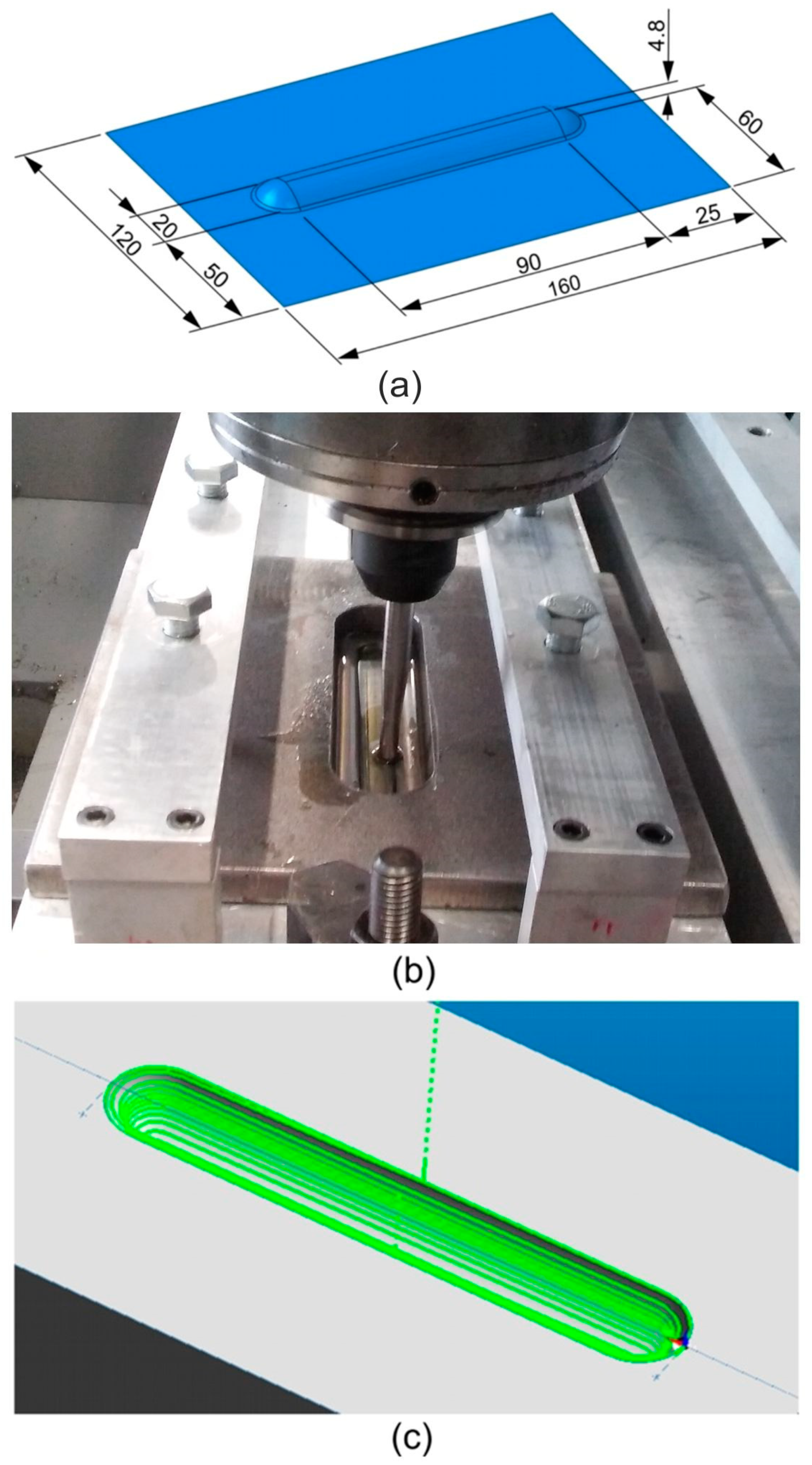

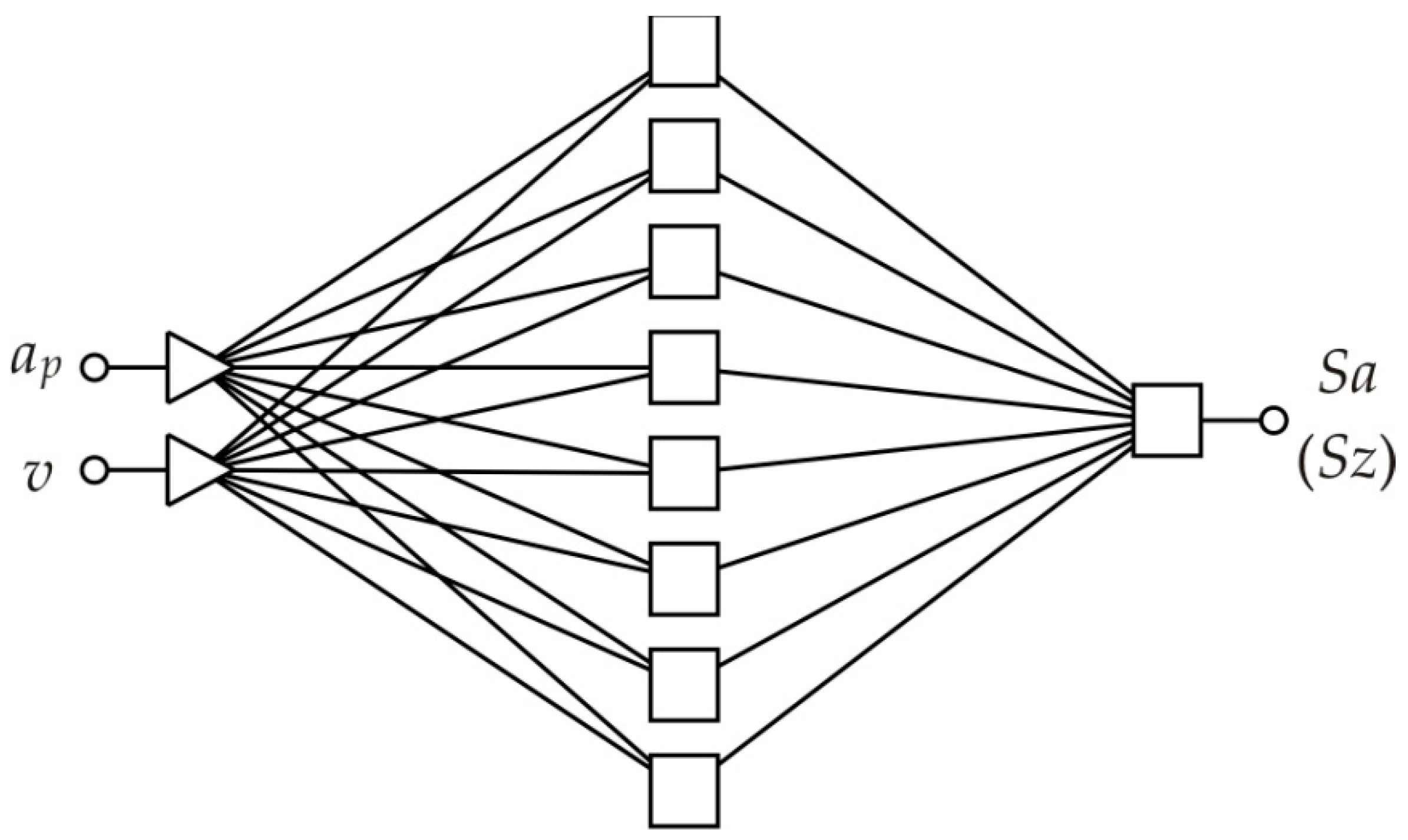

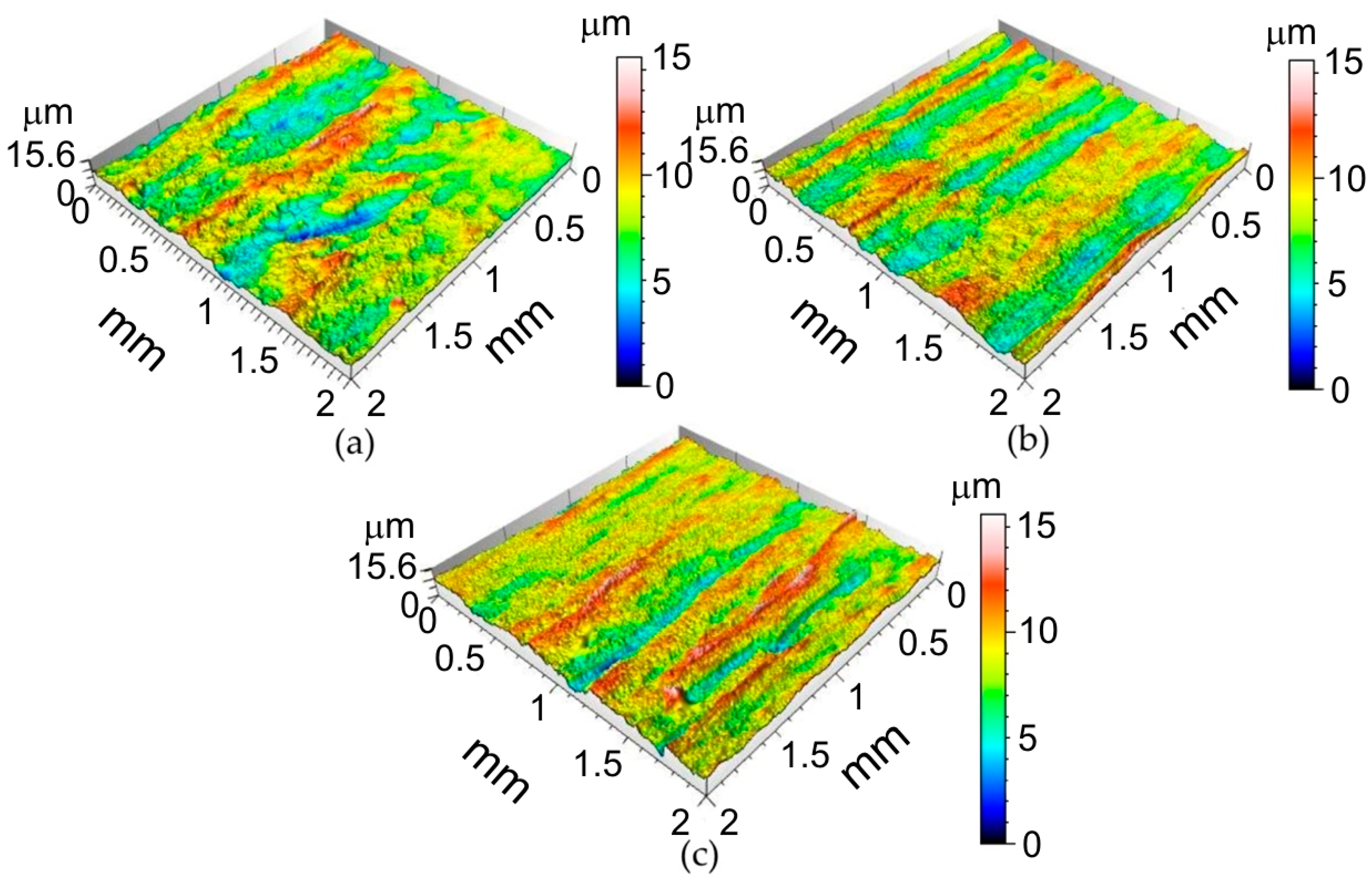

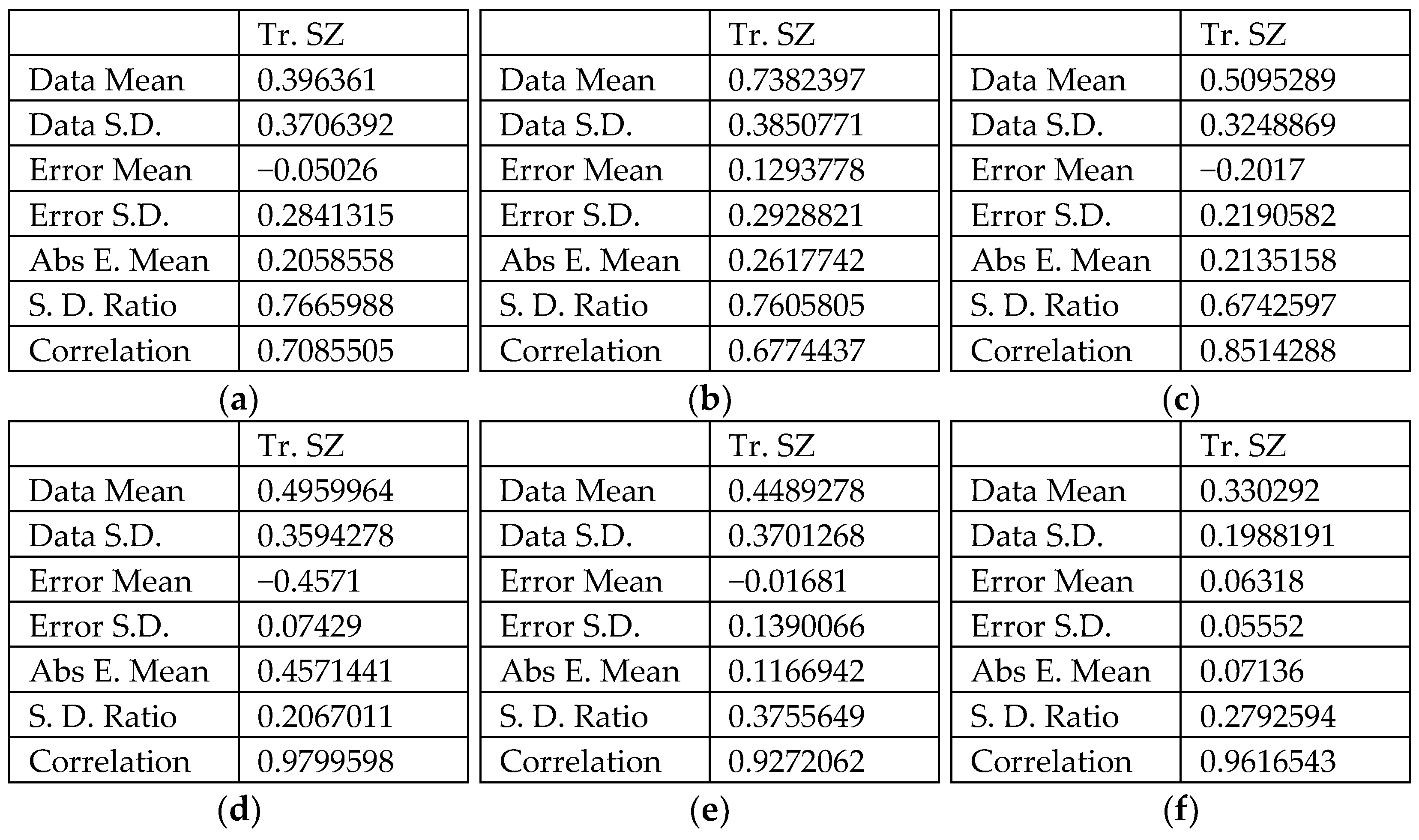

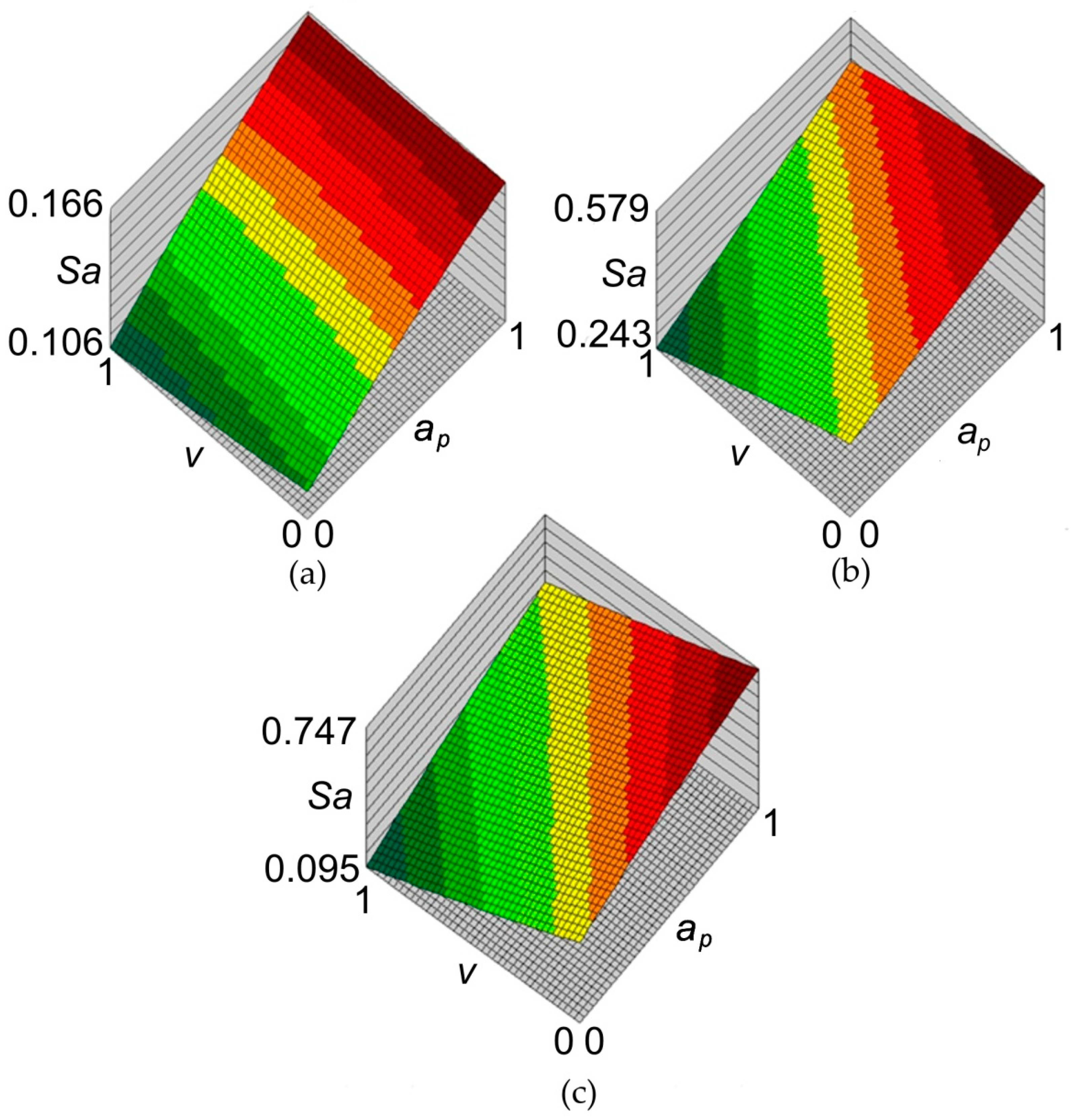
| Alloy | Si | Fe | Mn | Cu | Mg | Cr | Zn | Ti | Other Elements | Al | |
|---|---|---|---|---|---|---|---|---|---|---|---|
| Each | Total | ||||||||||
| 2024-T3 | 0.50 | 0.50 | 0.3–0.9 | 3.8–4.9 | 1.2–1.8 | 0.10 | 0.25 | 0.15 | 0.05 | 0.15 | Remainder |
| 7075-T6 | 0.40 | 0.50 | 0.30 | 1.2–2.0 | 2.1–2.9 | 0.18–0.28 | 5.1–6.1 | 0.20 | 0.05 | 0.15 | Remainder |
| Material | Temper | Specified Thickness, mm | Tensile Strength Rm, MPa | Yield Stress Rp0.2, MPa | Elongation A50 min, % | ||||
|---|---|---|---|---|---|---|---|---|---|
| Over | Through | min | max | min | max | ||||
| EN AW-2024 Alclad | T3 | 0.25 | 0.50 | 405 | - | 270 | - | 12 | |
| EN AW-2024 | T3 | 0.50 | 3.20 | 435 | - | 290 | - | 15 | |
| EN AW-7075 Alclad | T6 | 0.32 | 1.00 | 490 | - | 420 | - | 8 | |
| Density ρ (at 15 °C), kg/m3 | Flash Point, °C | Pour Point, °C | Viscosity at 40 °C, mm2/s | Viscosity Index |
|---|---|---|---|---|
| 879 | 210 | −45 | 72.4 | 157 |
| Number of Experiment | Incremental Vertical Step Size ap, mm | Tool Rotational Speed v, rpm |
|---|---|---|
| E1 | 0.2 | 18 |
| E2 | 0.2 | 110 |
| E3 | 0.2 | 202 |
| E4 | 0.3 | 18 |
| E5 | 0.3 | 110 |
| E6 | 0.3 | 202 |
| E7 | 0.4 | 18 |
| E8 | 0.4 | 110 |
| E9 | 0.4 | 202 |
| ap, mm | v, rpm | Sq, μm | Ssk | Sku | Sp, μm | Sv, μm | Sz, μm | Sa, μm |
|---|---|---|---|---|---|---|---|---|
| 0.2 | 18 | 1.09 | 0.355 | 3.10 | 5.16 | 4.33 | 9.49 | 0.874 |
| 110 | 0.94 | 0.0009 | 2.73 | 3.85 | 3.69 | 7.54 | 0.733 | |
| 202 | 0.99 | −0.0872 | 2.60 | 4.05 | 4.30 | 8.36 | 0.799 | |
| 0.3 | 18 | 1.16 | −0.321 | 3.37 | 3.86 | 4.67 | 8.53 | 0.914 |
| 110 | 1.53 | 0.0228 | 2.45 | 5.09 | 4.77 | 9.86 | 1.26 | |
| 202 | 0.93 | −0.184 | 3.50 | 3.34 | 4.91 | 8.25 | 0.737 | |
| 0.4 | 18 | 1.92 | 0.192 | 2.65 | 7.12 | 8.51 | 15.6 | 1.59 |
| 110 | 1.19 | 0.0649 | 3.35 | 4.93 | 6.65 | 11.6 | 0.940 | |
| 202 | 1.39 | −0.0958 | 3.69 | 4.88 | 8.29 | 13.2 | 1.09 |
| Sheet Material | Output Variable | RMSE for Training Set | ||
|---|---|---|---|---|
| Quasi-Newton | Back Propagation | Levenberg–Marquardt | ||
| 0.4-mm-thick EN AW-2024-T3 Alclad | Sa | 0.1206 | 0.1278 | 0.1381 |
| Sz | 0.4624 | 0.4821 | 0.4997 | |
| 0.8-mm-thick EN AW-7075-T6 Alclad | Sa | 0.3004 | 0.3189 | 0.3047 |
| Sz | 0.0817 | 0.0974 | 0.1086 | |
| 1-mm-thick EN AW-2024-T3 | Sa | 0.2860 | 0.3068 | 0.3091 |
| Sz | 0.1311 | 0.1457 | 0.1531 | |
Publisher’s Note: MDPI stays neutral with regard to jurisdictional claims in published maps and institutional affiliations. |
© 2021 by the authors. Licensee MDPI, Basel, Switzerland. This article is an open access article distributed under the terms and conditions of the Creative Commons Attribution (CC BY) license (http://creativecommons.org/licenses/by/4.0/).
Share and Cite
Trzepieciński, T.; Kubit, A.; Dzierwa, A.; Krasowski, B.; Jurczak, W. Surface Finish Analysis in Single Point Incremental Sheet Forming of Rib-Stiffened 2024-T3 and 7075-T6 Alclad Aluminium Alloy Panels. Materials 2021, 14, 1640. https://doi.org/10.3390/ma14071640
Trzepieciński T, Kubit A, Dzierwa A, Krasowski B, Jurczak W. Surface Finish Analysis in Single Point Incremental Sheet Forming of Rib-Stiffened 2024-T3 and 7075-T6 Alclad Aluminium Alloy Panels. Materials. 2021; 14(7):1640. https://doi.org/10.3390/ma14071640
Chicago/Turabian StyleTrzepieciński, Tomasz, Andrzej Kubit, Andrzej Dzierwa, Bogdan Krasowski, and Wojciech Jurczak. 2021. "Surface Finish Analysis in Single Point Incremental Sheet Forming of Rib-Stiffened 2024-T3 and 7075-T6 Alclad Aluminium Alloy Panels" Materials 14, no. 7: 1640. https://doi.org/10.3390/ma14071640
APA StyleTrzepieciński, T., Kubit, A., Dzierwa, A., Krasowski, B., & Jurczak, W. (2021). Surface Finish Analysis in Single Point Incremental Sheet Forming of Rib-Stiffened 2024-T3 and 7075-T6 Alclad Aluminium Alloy Panels. Materials, 14(7), 1640. https://doi.org/10.3390/ma14071640








